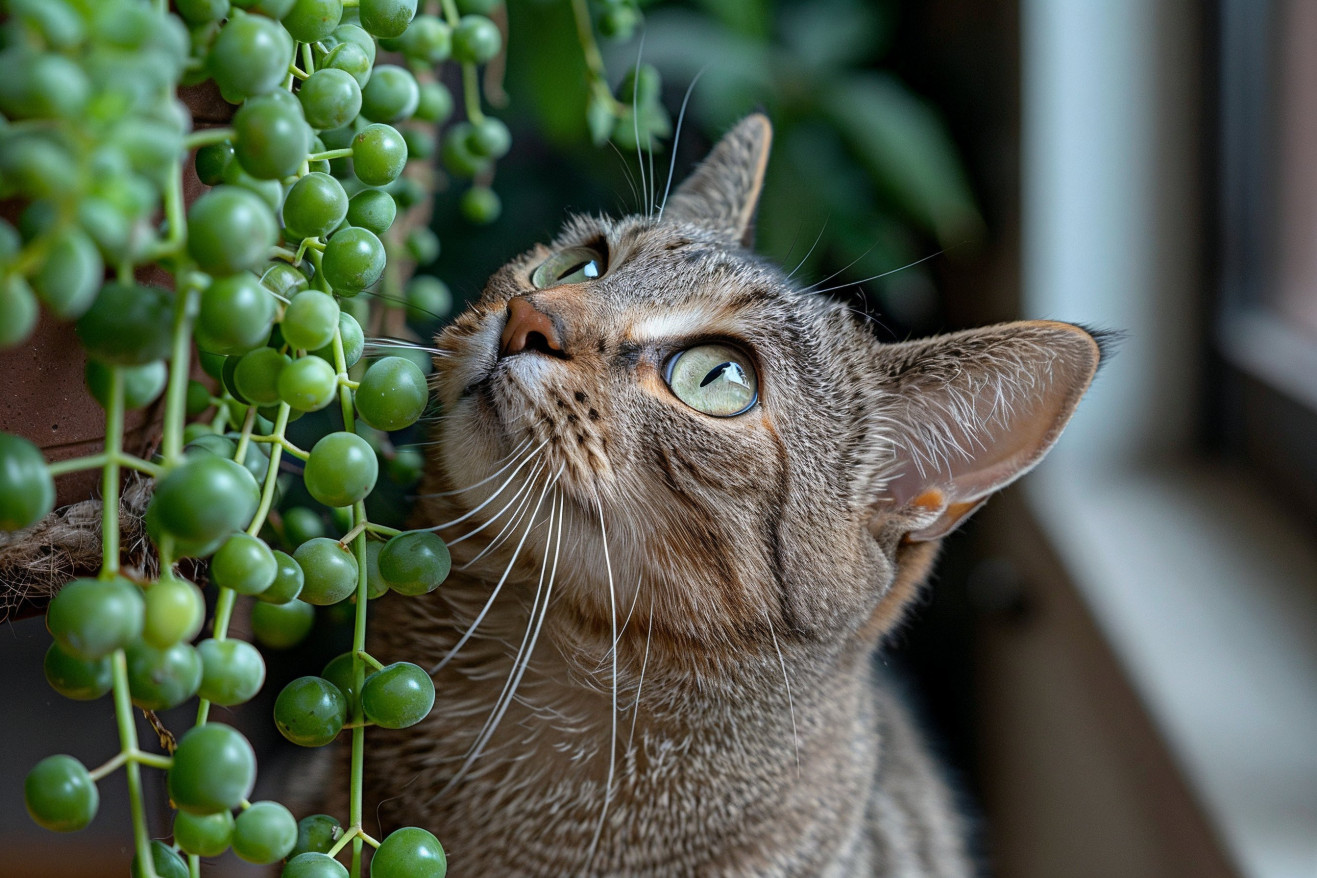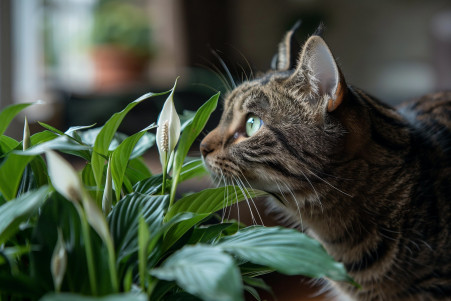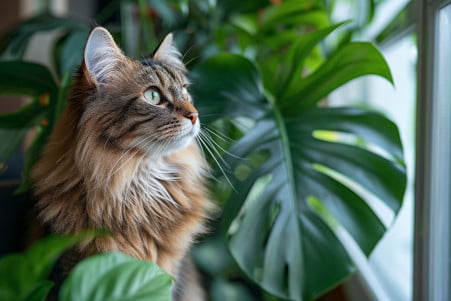Can String of Pearls Poison Cats? Understanding the Risks
7 June 2024 • Updated 5 June 2024

If you have a cat, you know that they can be quite the handful, especially when it comes to your indoor plants. But can your cat's curiosity lead to a string of pearls poisoning? While string of pearls plants are toxic to cats, the effects of ingestion are relatively mild and include vomiting, diarrhea, lethargy, and lack of coordination. That said, it's still a good idea to keep these popular succulents away from your cat to avoid any unnecessary issues.
To learn more about the dangers and symptoms of string of pearls poisoning in cats, we'll take a look at the scientific literature and data from veterinary toxicology studies and poison control centers. This will help us determine the specific toxic components, how they work, the symptoms of poisoning, and the best ways to treat your cat if they accidentally eat a string of pearls plant. By the end, you'll have a good understanding of how to make sure your cat and your string of pearls plant can coexist safely.
Are string of pearls toxic to cats?
Toxic Chemicals and Modes of Toxicity
The string of pearls plant is known to contain irritant sap and pyrrolizidine alkaloids, both of which can be toxic to cats if ingested. These alkaloids can inhibit cell division and may cause liver damage if consumed in large amounts. Vomiting and diarrhea are common symptoms of the body's attempt to rid itself of these toxic substances.
Lethargy and lack of coordination may also be signs that the plant's toxins are impacting the cat's nervous system. The ASPCA's toxic plant database notes that it's important to know the specific chemicals and modes of toxicity to determine the best course of action. While some cases may be treated with supportive care, more serious cases may require aggressive treatment to prevent organ failure and metabolic issues.
Clinical Symptoms of Poisoning
If a cat has ingested the string of pearls plant, some of the most common symptoms are vomiting, diarrhea, and lethargy, says Cat Behavior Consultant - Feline Fab. Skin or mouth irritation is also possible if the cat has come into contact with the plant's sap. In the most extreme cases, cats may experience seizures, tremors, or difficulty breathing, according to Variegated String of Pearls is Toxic to Cats.
The severity of symptoms will depend on the amount of the plant the cat has ingested, as well as the cat's overall size and health. If you notice early symptoms like drooling, loss of appetite, or restlessness, it could be a sign that your cat has ingested something toxic, says The Ultimate List of Toxic Plants for Cats. That said, it's important to get your cat to the vet as soon as possible so that they can help manage these symptoms and prevent any further issues.
First Aid and Veterinary Care
If you suspect that your cat has eaten a string of pearls plant, it is important to seek veterinary care or contact a pet poison hotline immediately, per Variegated String of Pearls is Toxic to Cats. Make sure to remove any plant material from your cat's mouth and take a sample of the plant to the vet for identification. Be prepared to share information about the incident, including how much of the plant you think your cat ate, when you think the ingestion occurred, and any symptoms that you have noticed.
The vet may induce vomiting, administer activated charcoal to help prevent the absorption of the plant's toxins, or provide supportive care and IV fluids, according to String Of Pearls Are Toxic To Cats. It's important to closely follow the vet's recommendations and ensure that your cat is carefully monitored, as the treatment will depend on the severity of your cat's exposure.
Although the string of pearls plant is only mildly toxic, there are many other popular houseplants that can be highly toxic to cats if they are ingested. Familiarizing yourself with safe plant options can help cat owners enjoy indoor plants without worrying about their cat's safety.
Non-Toxic Succulents for Cat Owners
In addition to the string of pearls plant, there are many other succulents that are safe for cat owners to keep in their homes. According to Epic Gardening, Echeverias, Sempervivums, Haworthiopsis, Sedums, Aeoniums, Lithops, Christmas cactus, Graptopetalums, Portulacaria, and Gasterias are all safe for cats and dogs.
The Spruce lists several succulents that are safe for cat owners to keep in their homes, including the Mexican Peacock Echeveria, Hens and Chicks, Chinese Money Plant, and Donkey's Tail. When purchasing new plants, PetMD recommends doing thorough research to make sure that the plants you're interested in are pet-safe and non-toxic.
In addition, according to Litter-Robot, hanging baskets and keeping plants in hard-to-reach places can help prevent cats from eating them. You can also use safe deterrents like vinegar or lemon sprays to keep cats away from plants. With these precautions in place, cat owners can enjoy succulents in their homes without worrying about their cats' safety.
More Toxic Houseplants for Cats
In addition to string of pearls, there are many other common houseplants that are toxic to cats if eaten. Some of the most toxic plants are lilies, which can cause kidney failure, and sago palms, oleander, and rhododendron, which can cause a variety of other serious problems, according to the 20 Houseplants That Are Toxic to Cats. Other plants that are toxic to cats include aloe vera, jade plants, and dieffenbachia, according to the ASPCA's toxic plant database.
Signs of plant poisoning can include vomiting, diarrhea, lethargy, and in some cases, organ damage or failure, according to Top 10 toxic household plants for pets. Cat parents are encouraged to thoroughly research any new plants and make sure that toxic plants are kept out of their cat's reach to prevent them from being eaten, according to the ASPCA's Toxic and Non-Toxic Plant List for Cats.
Conclusion: How to Safely Keep Plants Around Cats
Although the string of pearls plant is only mildly toxic to cats, there are many succulent options that are non-toxic. It’s important to do thorough research before bringing any new plants into a home with pets. By keeping toxic plants in places that cats can’t get to and using deterrents, cats can be kept safe from ingesting poisonous plants.
If a cat does eat a toxic plant, it’s important to get them to the vet as soon as possible for the best chance of recovery. With the right measures in place, cat owners can enjoy a lush, green home while keeping their pets safe.


